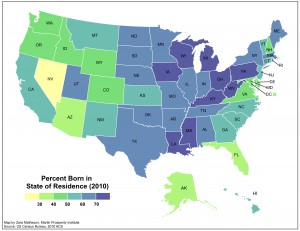
What does it mean when 78.9 percent of today’s Louisianans were born there?
Nothing good, infers Richard Florida, Senior Editor at The Atlantic and Director of the Martin Prosperity Institute at the University of Toronto’s Rotman School of Management, on The Atlantic Cities blog.
States, like Ohio, where 75 percent of residents are natives, show a low degree of mobility. ‘A high level of home-grown residents is also indicative of a lack of inflow of new people’, notes Florida.
By contrast, ‘just 24.3 percent of Nevadans, 35.2 percent of Floridians, [and] 37.2 percent of the residents of Washington, D.C.’ were born there.
Florida draws some sweeping conclusions from this state-level data:
There is a distinctive “stuck belt” across the middle of the country running from Pennsylvania, Ohio, Michigan, Wisconsin, and Iowa, down through West Virginia and into the Sunbelt states of Kentucky, Alabama, Mississippi and Louisiana. Mobility is largely a bi-coastal—plus Rocky Mountain state—phenomenon.
America can be divided into two distinct classes, the stuck and the mobile. The mobile possess the resources and the inclination to seek out and move to locations where they pursue economic opportunity. Too many Americans are stuck in places with limited resources and opportunities. This geography of the stuck and mobile is a key axis of cleavage in the United States.
Far better than ‘the Rust Belt’, a ‘Stuck Belt’ expresses a perception of life in bands of central states. Stuck, hopelessly stuck.
The previous tenants of my first Ohio State apartment – a basement in a slum on Chittenden Ave. – had left in the bathroom mirror ‘the word for the day’ from The Lantern, the student newspaper: ‘Committing suicide in Columbus, Ohio, is redundant.’ It sure captured the Spring 1970 zeitgeist. But it wasn’t true then or now.
I know from living in and traveling ‘the Stuck Belt’ that its explanation can be much more complex, much more local, much less subject to categorisation. A county map reveals far more than a state map about Richard Florida’s ‘geography of stuck’.
In 1970, the Appalachian counties of Ohio were a great place to be from, while Columbus was ‘a great place to raise a family.’ Both statements are true today, as the depopulated hill country and the vibrant flat lands prove.
You could make similar intra-state generalisations about Wisconsin and some other ‘Stuck Belt’ states, but you would be hard-pressed to do so in the band from West Virginia and Kentucky to Mississippi and Louisiana, from the Ohio River’s south bank to the Gulf’s north coast.
Nonetheless, ‘[t]his geography of the stuck and mobile is a key axis of cleavage in the United States.’
‘The Stuck Belt’ more or less overlays the states dominated by big-time public university football and, to a lesser degree, basketball. That tells you much about the attitudes toward public education and the multiple ethnic divides that also track this ‘axis of cleavage’. You also see in its eastern reaches the remnants of the Scots-Irish ascendency.
‘The Stuck Belt’ reflects the track of the 20th century’s American great migrations: at mid-century from subsistence farming or sharecropping regions to the industrial north and the late century the snow-bird flight from the destinations of the earlier migrations.
‘The Stuck Belt’ may reflect a broader reordering, reconception of American society.
The lessons of – if not the responsibility for – the past thirty years of economic stagnation and the consequent demise of the American notion of ‘opportunity’ may have sunk in.
Why abandon support systems if there’s no promise of a better life without them? Why support public education when it bears no apparent reward either for the investment in taxes or for the work to get one or for the student loans it will take years to pay off?
The lessons for today’s ‘Stuck Belt’ residents bring to mind a vaudeville sketch from the 20th century’s first great migration. Its punch line has the rube, realising he’s been taken by a shyster’s topsy-turvy, exclaiming, ‘Dat means you is the stuckee, and I is the stuckor!’
Of such insights will be made the 21st century’s Great Awakening.
Recent Comments